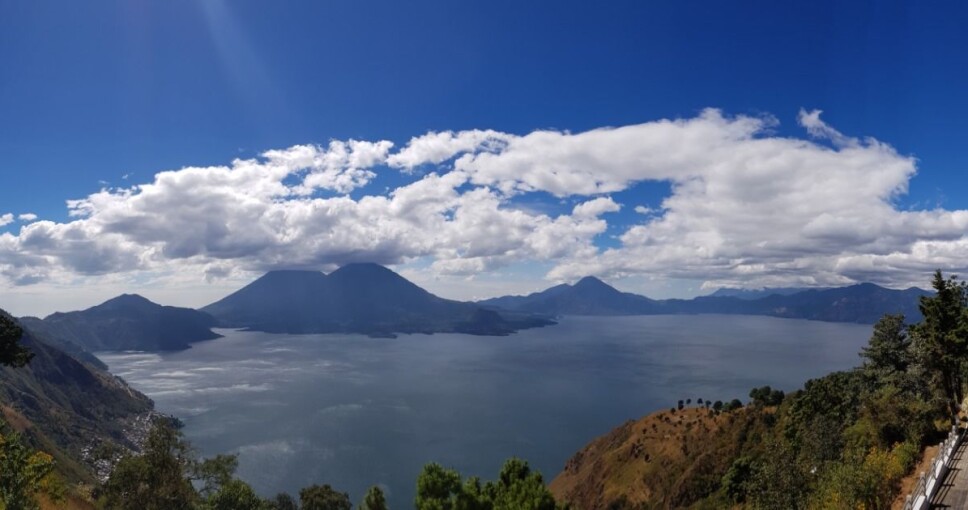This article is produced and financed by University of Oslo - read more

Volcanic emissions can cause changes in the atmosphere over a long time
When Los Chocoyos in Guatemala erupted 84,000 years ago, emissions of sulfur and chlorine may have affected the climate for decades.
The super volcano Los Chocoyos (14.6∘ N, 91.2∘ W) in Guatemala, Central America, erupted about 84,000 years ago, and was one of the largest volcanic events of the last 100,000 years.
Recent petrological data shows that the Los Chocoyos eruption released large amounts of sulphur and ozone-depleting chlorine and bromine gases.
The volcano was part of the well-known Ring of Fire, located like a horseshoe around and in the Pacific. This is an earthquake zone, where we find 75 per cent of all known volcanoes (both active and dormant). The volcanoes Atitlán and Tolimán followed the Los Chocoyos eruption, and remain active today.
In an eruption, super volcanoes can cause enormous destruction locally, but also have major impacts across the globe due to the huge gas and dust emissions to the atmosphere. And as one research group now shows, give major changes in the atmosphere over several years.
Weakened ozone layer
Based on the Los Chocoyos eruption, scientists from the University of Oslo (UiO), GEOMAR and NCAR simulated emissions of gaseous sulphur and halogen to the atmosphere in pre-industrial times. They used the American earth system Community Earth System Model (CESM)/Whole Atmosphere Community Climate Model (WACCM) with interactive «emissions» of volcanic aerosols and gases into the atmosphere.
The runs showed that elevated amounts of sulphate and aerosol optical depth (AOD) from the eruption would persist for five years in the atmosphere, and the amount of halogen would remain high for almost 15 years.
As a consequence of this change in atmospheric chemistry, the ozone layer would collapse. The researchers found an 80 per cent reduction in the ozone layer as a global average.
«Ozone weakening on this scale could cause a 550 per cent increase in UV radiation in the first five years after the eruption, which could have very serious potential impacts on humans and the biosphere,» says Hans Brenna, first author of the study. He is a doctoral student at the Department of Geosciences at UiO and a researcher at the Norwegian Meteorological Institute.
The effect on the climate after such a huge volcanic eruption will last up to several decades.
«Recovery to pre-eruption ozone levels and climate takes 15 years and 30 years, respectively, according to results from the simulations. The long-lasting effect of cooling the Earth's surface is sustained by an immediate increase in the sea ice area in the Arctic, followed by a decline in ocean heat transport at 60° N to the Arctic Ocean. This effect persists for up to 20 years,» says Kirstin Krüger, a professor of meteorology at UiO.
The effect of the eruption strikes differently
The researchers also found that the impact of volcanic eruptions would be different in different parts of the globe. In the northern hemisphere the eruption would cause cooling due to increased atmospheric aerosols, which would increase precipitation and result in a decrease in primary production of more than 25 per cent. They also found that sea ice cover would increase by 40 per cent in the first 3 years.
At the equator and in the northern parts of Africa, the eruption would cause increased humidity and result in much higher primary production in the first five years after the eruption. There would be a shift of the low pressure zone at the equator known as the Intertropical Convergence Zone (ITCZ), which would move more towards southern latitudes. In addition, the sea would react with El Niño-like mechanisms during the first three years; those would also shift southward.
«Because the model uncertainties for climate response and atmospheric chemistry in volcanic eruptions are large, such simulations as ours would have to be supported by physical samples from paleo-archives such as ice and sediment cores and a coordinated model intercomparison,» Brenna emphasises.
Reference:
Hans Brenna et.al: The potential impacts of a sulfur- and halogen-rich supereruption such as Los Chocoyos on the atmosphere and climate. Atmos. Chem. Phys., 2020. https://doi.org/10.5194/acp-20-6521-2020
———
Read the Norwegian version of this article at forskning.no


































